2023 Review of Spectroscopic Instrumentation
This article presents our annual review of spectroscopy products introduced since May of 2022. Some of the products were introduced at Pittcon 2023, which was live in Philadelphia, Pennsylvania, and some were introduced prior to that. The products introduced and described here illustrate that analytical chemistry is a diverse and thriving field, and that device manufacturers respond to the changing demands of the discipline.
Pittcon is back!
After a two-year hiatus because of the Covid-19 pandemic, Pittcon was once again hosted in-person. The 2023 conference took place in Philadelphia, Pennsylvania, and it attracted approximately 5000 attendees and 2500 exhibitor personnel representing almost 500 exhibitors. Exhibitors ranged from major instrument companies to supplies and consumables, service laboratories, professional societies, and publications.
It was evident in the exhibit hall that everyone was interested in connecting in person. Whether it was professional colleagues that have worked together virtually over the past two years, or exhibitors and conference attendees being able to connect in-person for the first time, it was obvious that people missed the interpersonal communication and camaraderie that in-person conferences facilitated, and were glad to reunite with old personal friends and colleagues, while connecting with new conference attendees.
In addition to writing this article, one of my reasons for attending Pittcon was because of my role as an officer of a professional society. Something I noted while spending time in the booth was that there were a large number of students and new scientists who were stopping by and asking questions. It reinforces the general consensus that a live conference benefits young researchers, because it offers them the opportunity to become more engaged with the analytical community.
However, not everything was completely back to normal. A colleague who was scheduled to present in a session found himself chairing the session because the chair was unable to travel, due to his institution’s rules. That was also true of two speakers in the same session; as a result, the number of speakers in the session was reduced. This instance is only one example that highlights the point that, although it may seem like the world is back to a pre-Covid normality, it is not quite there yet.
There were some companies that had traditionally exhibited at Pittcon that were missing, but also new (to me) companies with interesting products. The trends noted last year—more dedicated analyzers and software that is fully integrated into laboratory operations—continues to be a theme in instrument development in 2023.
In particular, engineering teams were hard at work in the last year. There are new products in all the categories we usually review, and many of them are designed to perform important functions critical to the analytical laboratory application the products are meant to be used for. In particular, the Pittcon Today Excellence awardees appear to have some exciting engineering behind their recent developments.
Another interesting theme observed with the new products launched this year was that many instrument manufacturers were focused on shrinking the footprint of traditional instruments. Some of the products described this year are highlighted as having reduced footprints, which is in keeping with the demands to make laboratories and laboratory space more efficient.
At the small end of footprint reduction, handheld instruments are becoming increasingly common and being developed to solve more problems in the field.
This article will be broken into four sections: instrumentation; accessories; components; and software. In this review, a clear distinction between an accessory and component was made to avoid confusion. For this product review, an accessory is defined as a product that is designed to be used with a completed instrument, whereas a component is defined as a product that can be used to construct the instrument
Pittcon Awards
With Pittcon being live this year rather than virtual, the Pittcon Today Excellence Awards returned as well. The awards criteria are based on true innovation. In each of the two categories based on company size, there were three awards: gold; silver; and bronze. This year, three spectroscopy products won awards.
In the annual sales over $10 million category, two of the three awards were in infrared (IR) spectroscopy, and both were microscopes. Bruker’s Hyperion II, an imaging microscope with the capability to combine laser imaging using quantum-cascade lasers (QCLs) with Fourier transform infrared (FT-IR) spectroscopy, took the Gold Award. The system is equipped with a focal plane array detector, but the novel aspect of this microscope is the optional QCL module that also relies on patented technology to eliminate artifacts that can be produced by typical laser sources.
The Silver Award went to Shimadzu for the AIRsight FT-IR/Raman combination microscope. The combination provides complementary spectroscopic information, and is designed to minimize the bench space that is used. The concept of having a microscope capable of performing both the FT-IR and Raman techniques is not novel, and academic publications, as well as patents and at least one semi-commercial product, have been described as possessing this capability in the past. But Shimadzu has made a commercial product, which also should appeal to the customer base, both for its functionality and for its smaller footprint than two instruments would produce. Also, of course, this approach allows the user to get complementary spectra from exactly the same spot.
In the under $10 million in annual sales category, ST Japan won the Gold Award for their LC-CollectIR product, an accessory that provided efficient analysis of components separated by liquid chromatography (LC). In a two-step process, the system eliminates the solvent from the LC, and deposits the eluent on a rotating germanium plate. The plate is then analyzed using IR.
Instrumentation
As we did last year, we are providing tables with information on the products. We will not describe every entry in detail, but refer the reader to the information in the tables.
Table I lists those companies that submitted product descriptions and the categories where the new products are listed. There were almost 50 new products that are described in this roundup, and the first major category we will cover is instrumentation.
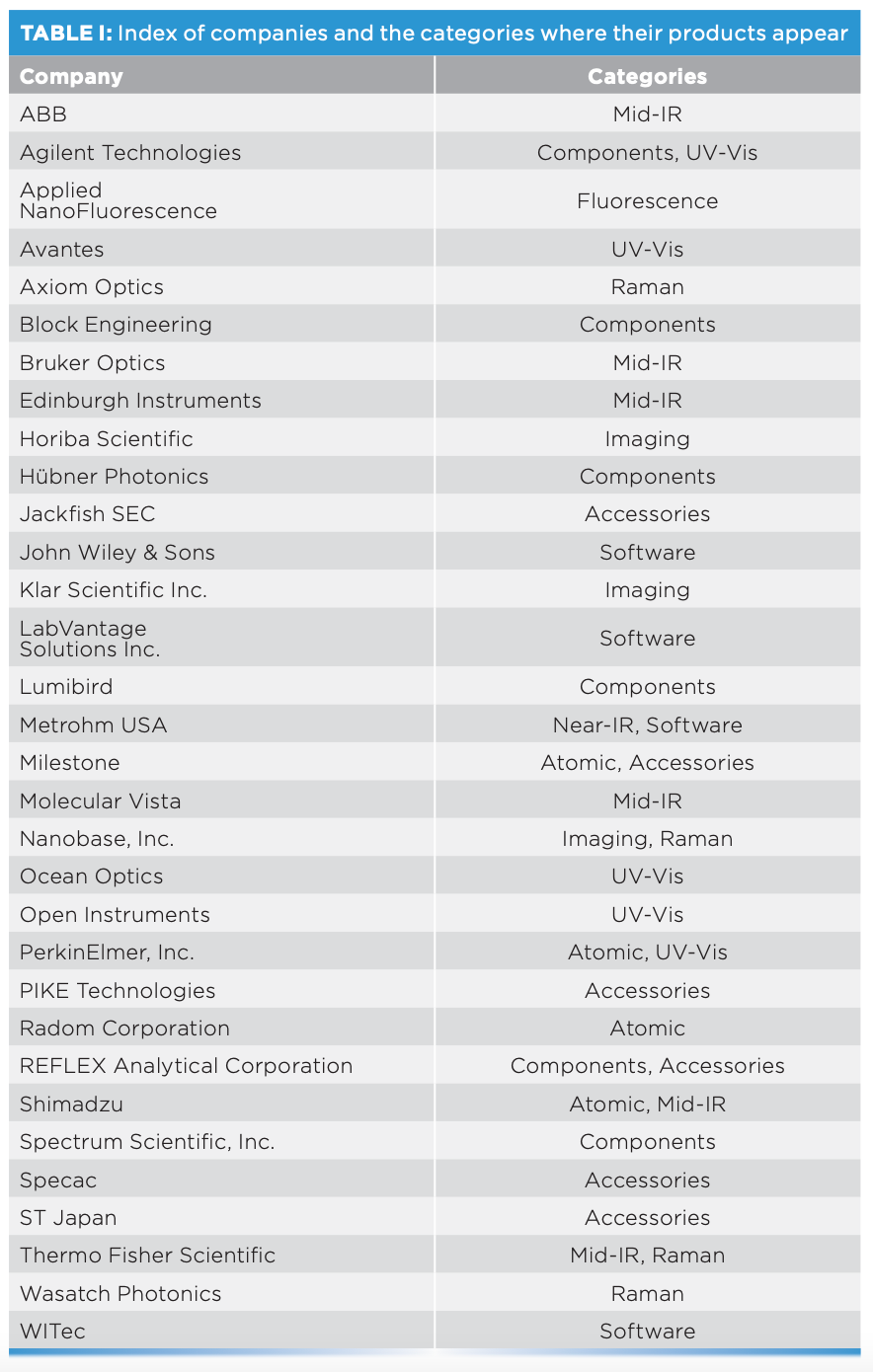
Atomic
In the atomic instrumentation category, we highlight five interesting products (Table II). Following the trend in all instrumentation, the products are all billed as easy to use. Two are sample digestion systems from PerkinElmer and Milestone. Shimadzu also introduced a new atomic absorption instrument and a new X-ray fluorescence (XRF) instrument.
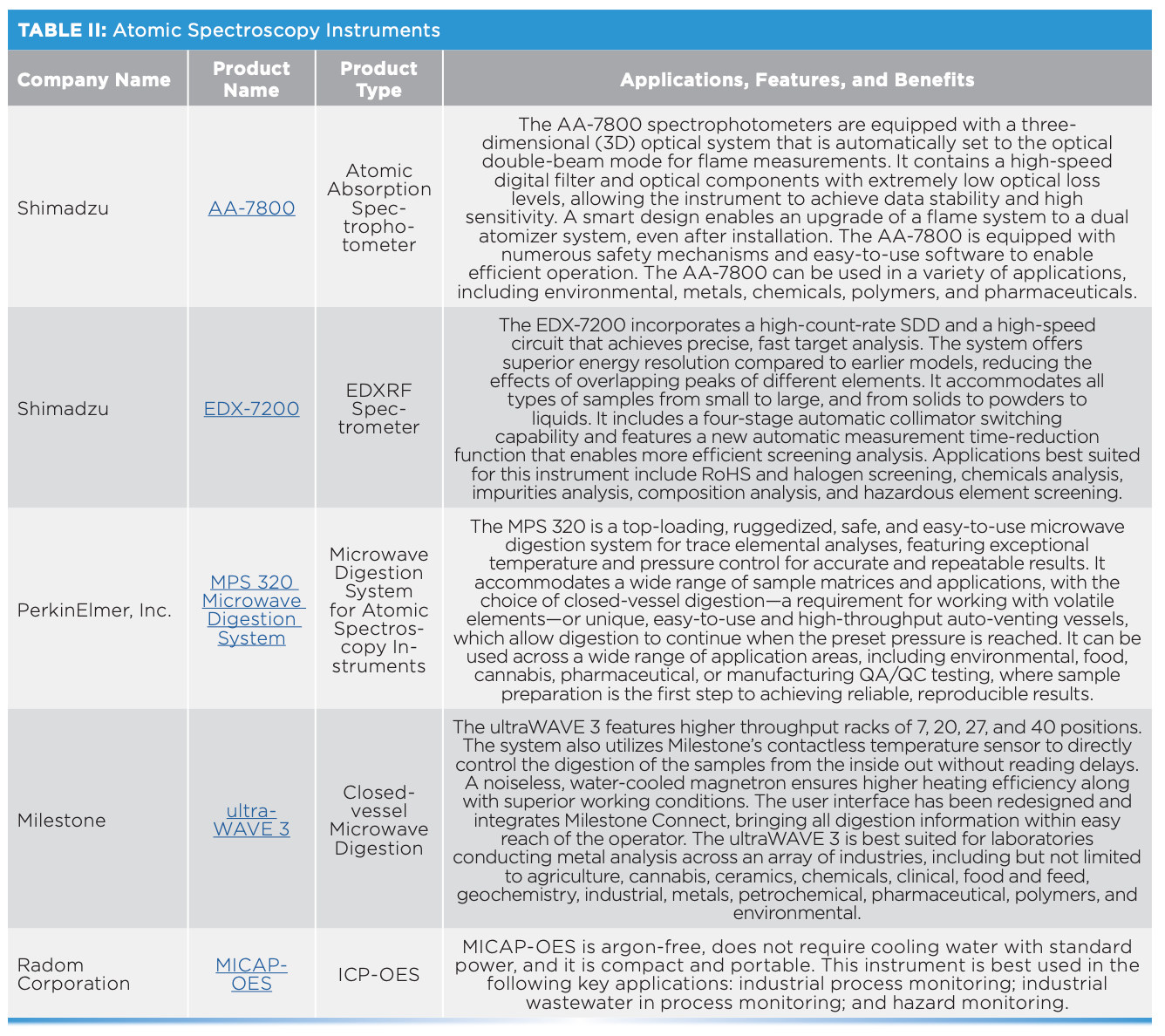
The one that is most interesting to me is the Radom MICAP-OES instrument. The MICAP-OES instrument does not require either argon or cooling water, because the instrument uses a microwave-generated plasma. The most appealing point about this instrument is that it is portable, and does not need any special support, making it ideal for those applications where a traditional instrument may not be appropriate.
Molecular
Molecular spectroscopy encompasses UV-visible (UV-vis), near-infrared (NIR), mid-infrared (Mid-IR), and Raman. It is among these four categories we find the bulk of the new instrument offerings.
UV-Vis
Starting with the UV-vis category (Table III), we find both traditional laboratory-based instruments and miniature instruments.
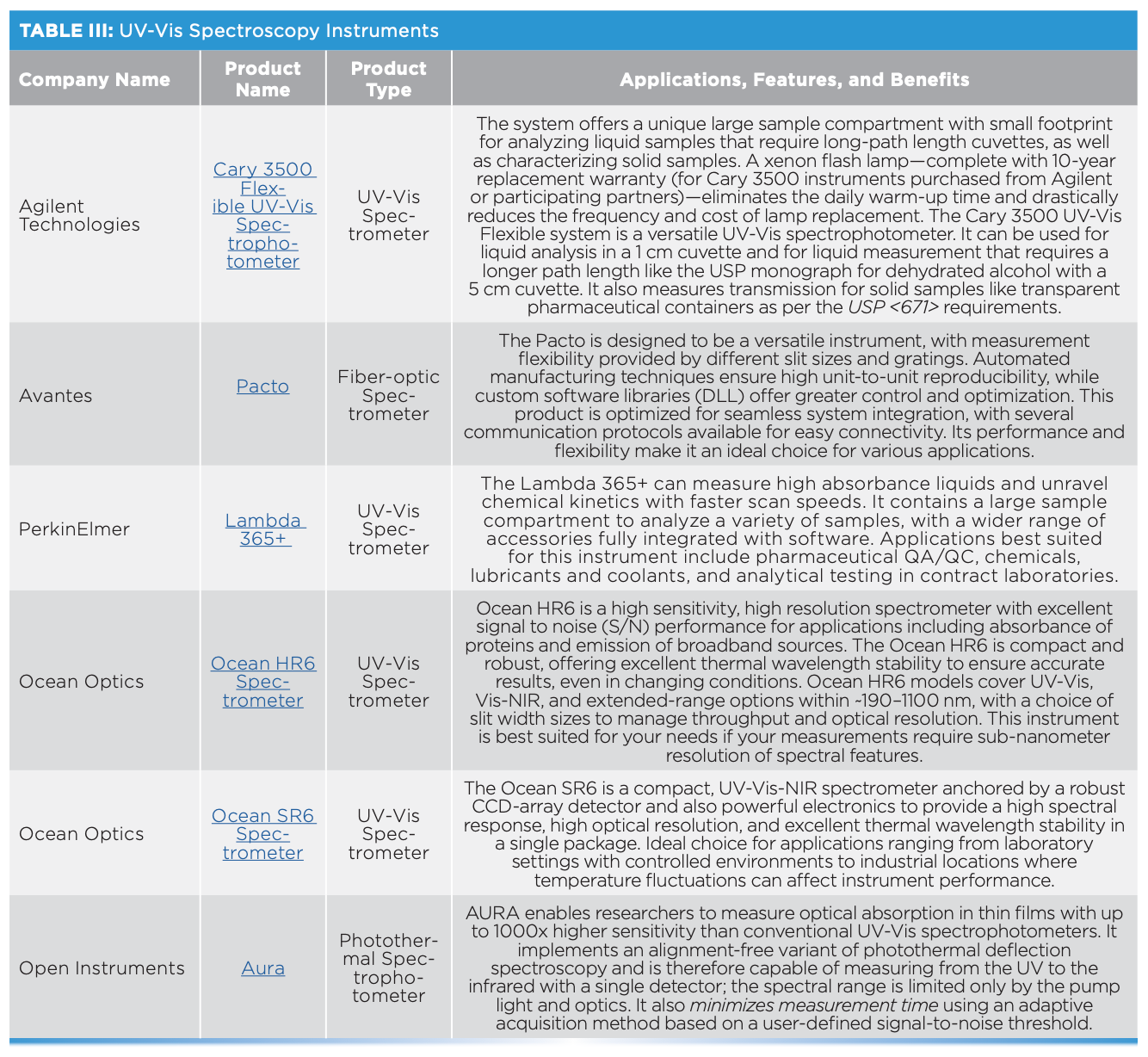
Agilent Technologies has introduced the Cary 3500, a lab-based UV-vis spectrophotometer with a very large sample compartment for flexibility. The instrument seems to have as large a sample compartment as the Cary research instruments, but this instrument is designed with a small footprint.
The PerkinElmer 365+ is a laboratory-based instrument designed to simplify analyses and be used by operators without extensive training. This is following a trend in laboratory instruments to design the software so that useful data is obtained without the operator being an expert.
The shrinking footprints trend we have seen in instrumentation is also the main feature of the other product introductions. All fall into the category of miniature spectrometers.
The Avantes Pacto is a fiber-coupled spectrometer that can be integrated into various systems.
Ocean Insight has introduced two instruments into this space. One is the SR6 series, which can cover from the UV (200 nm) to the very NIR (1100 nm), and it is designed to provide thermal wavelength stability, which is a challenge for small instruments that might be used in non-ideal environments. The other Ocean offering, the HR6, has a similar spectral range and thermal stability, but it is designed to provide a higher spectral resolution.
An interesting new instrument from Open Instruments in Australia also falls into the UV-vis category. This instrument, a photothermal deflection spectrometer, was originally designed for use in characterizing solar cells, but may present some interesting features making it applicable to other technical areas.
Fluorescence
In the fluorescence category, one new product (see Table IV) entered the market. Applied NanoFluorescence introduced the NS Super Chiroptical, an instrument based on near-infrared fluorescence detected circular dichroism. According to the company, this instrument came out of developments for the National Institute of Standards and Technology (NIST) to measure the enantiomers of single-walled carbon nanotubes.

Vibrational
In the vibrational spectroscopy category, we saw some noteworthy products that were introduced. Two of the three microscopes were discussed when we covered the Pittcon Today Excellence Awards, but there were a number of other interesting introductions.
Near-IR
Table V features the NIR products that were introduced over the past year. In particular, Metrohm has been busy with a number of introductions in the category. Metrohm has introduced a family of analyzers designed for process control, and have the option of sampling for solids or liquids. The Polymer analyzer has a solid sample interface, and the Polyol analyzer has a liquid sampling interface.
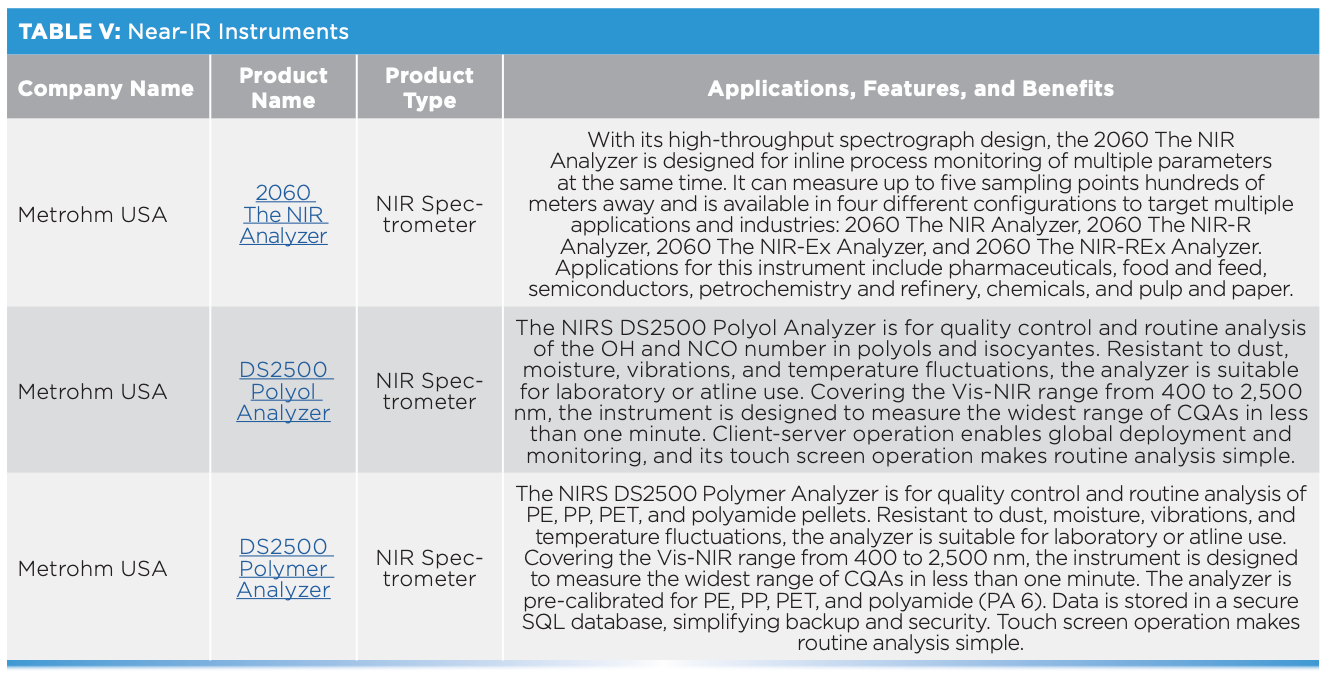
In addition to the two analyzers mentioned above, Metrohm has also introduced the 2060, which is a NIR instrument designed for inline process applications. It can monitor a variety of parameters at the same time, and has up to five sampling points.
Mid-IR
The past year has brought some interesting devices to the market in the workhorse category of mid-infrared (see Table VI). We commented on the Bruker Hyperion II and the Shimadzu AIRsight FT-IR/Raman microscope in the discussion of the Pittcon awards, but Shimadzu also introduced the AIMsight, an FT-IR microscope.

ABB has introduced a process instrument, the Sensi+, for online measurements of contaminants in natural gas streams. The instrument is based on ABB’s unique laser absorption technology called Integrated Cavity Output Spectroscopy (ICOS).
Edinburgh Instruments has put a new entry into the crowded FT-IR area by introducing the IR5 FT-IR instrument. The specifications as noted on the Edinburgh website put this instrument right in the category of the midrange instruments, but what makes this instrument unique is the ability to do photoluminescence in the IR region.
Molecular Vista provided a new product, the Vista 75, that is a photo-induced force microscope, and it provides high spatial resolution. This instrument is a new entry into the rapidly growing field of nano IR spectroscopy, which is designed to address the spot or feature size versus diffraction limit problem of traditional infrared microscopy.
Finally, for this category, Thermo Fisher Scientific has a new product, the Summit X FT-IR. This device follows the trend to make footprints smaller and instruments more intuitive for the user, and is described as portable. The application space is the same as most other FT-IR instruments in polymers, pharmaceuticals, and materials.
Raman
Introductions in the Raman category, shown in Table VII, mirror those in the UV-vis category in that both laboratory-based research instruments and miniature instruments were introduced.

Nanobase has introduced a research Raman instrument integrated with a cryostat system from Montana Instruments to study material at low temperatures.
Another research instrument introduced this past year is the Thermo Fisher Scientific DXR3, a laboratory instrument with a reduced footprint that is designed to integrate with other analytical techniques.
Wasatch Photonics has two new offerings. The first, the WP Raman XL Series instruments, are small footprint devices that are user configurable and deliver research level performance. It can be configured with a variety of excitation wavelengths. Wasatch has also introduced the WP Raman XM Series, a family of similar devices designed for OEM applications
Axiom Optics has introduced the GoyaLab IndiGo Raman spectrometer, which joins the family of other IndiGo devices. This Raman instrument is designed with either 532 or 785 excitation, and fits in the palm of the user’s hand. It connects wirelessly to smartphones and tablets for field applications.
Imaging Instruments
Imaging has become a general term to describe systems that produce a multidimensional data set regardless of how the sample is interrogated. That definition certainly applies to the instrument in this year’s category described in Table VIII.

Horiba has introduced a family of X-ray analytical microscopes to address areas, such as archaeology and geology, where nondestructive analysis is necessary.
Another imaging instrument using an entirely different technology, the Phocuscan, is from Nanobase, and it offers a standalone photocurrent microscope for applications in areas such as, but not limited to, nanotechnology and semiconductors.
The third imaging instrument—this one from Klar Scientific—is a photo-luminescent spectroscopic confocal scanning microscope with excitation from the deep UV to the NIR. It is modular in design, and allows the researcher to quickly change the configuration to meet the needs of the experiment.
Accessories
Last year, we stated that the definition of an accessory was that it was designed to be used with a complete instrument compared to a component that becomes part of the instrument. We are continuing with that definition for this year, and Table IX describes the products in the accessory category.
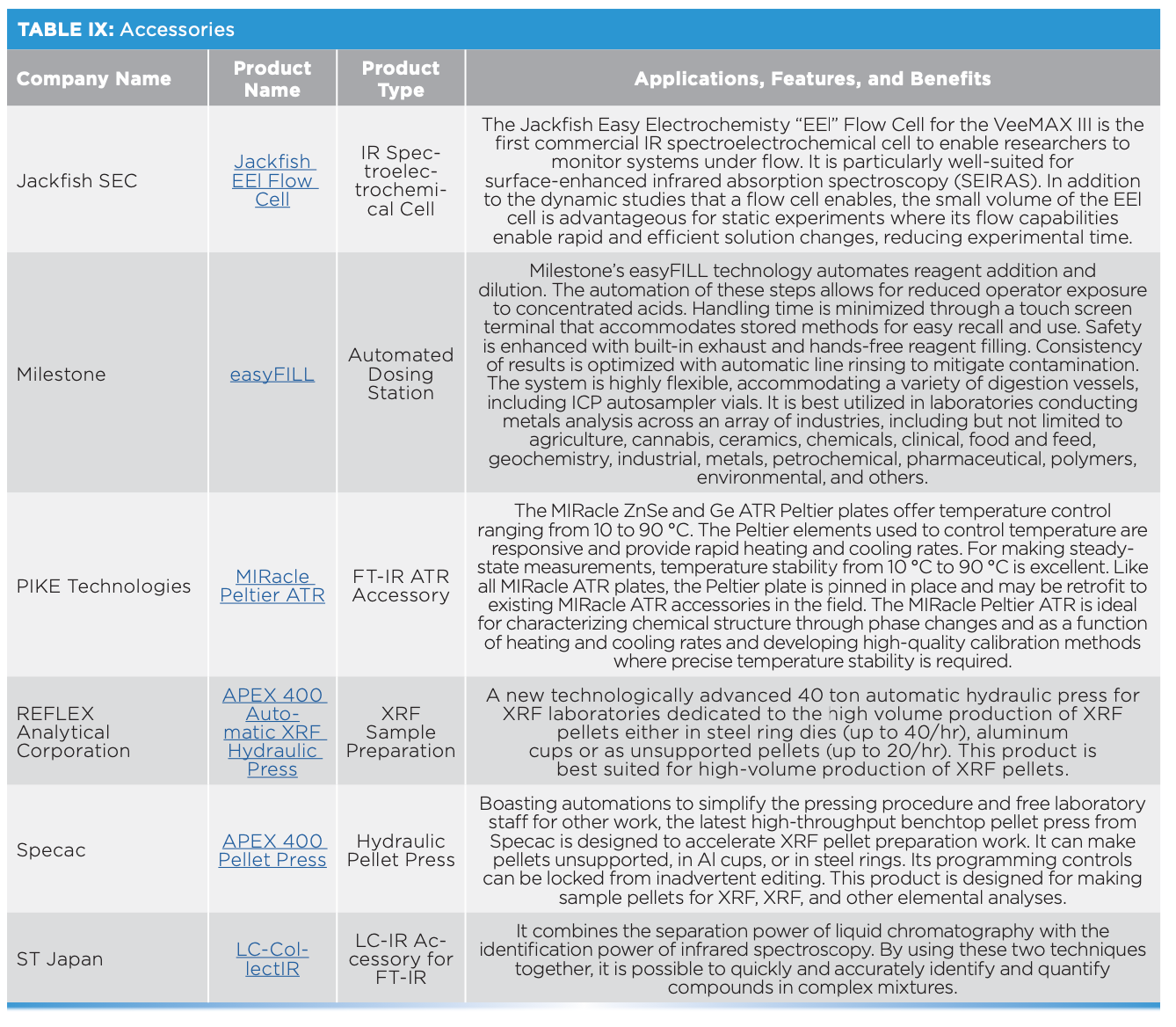
Three of the accessories introduced in the past year are designed for FT-IR. The Jackfish EEI Flow cell from Jackfish SEC is a spectro-electrochemical cell and allows researchers to study electrochemical systems under flow. It is well-suited for surface-enhanced infrared reflection absorption spectroscopy (SERIAS) applications. Pike Technologies has introduced a Peltier heated and cooled version of the MIRacle to study systems at elevated and reduced temperatures or in situations where precise temperature stability is needed. The third FT-IT accessory is the LC-CollectIR from ST Japan that was described earlier when we discussed the Pittcon Excellence awards.
Both Specac and Reflex Analytical have introduced the Apex 400 Automatic Hydraulic Pellet press. To round out the accessory category, Milestone has introduced an automated dosing station to automate reagent addition and dilution and is especially useful to reduce operator exposure and provide consistency of results.
Components
Under components, there are entries in a variety of areas as illustrated in Table X.
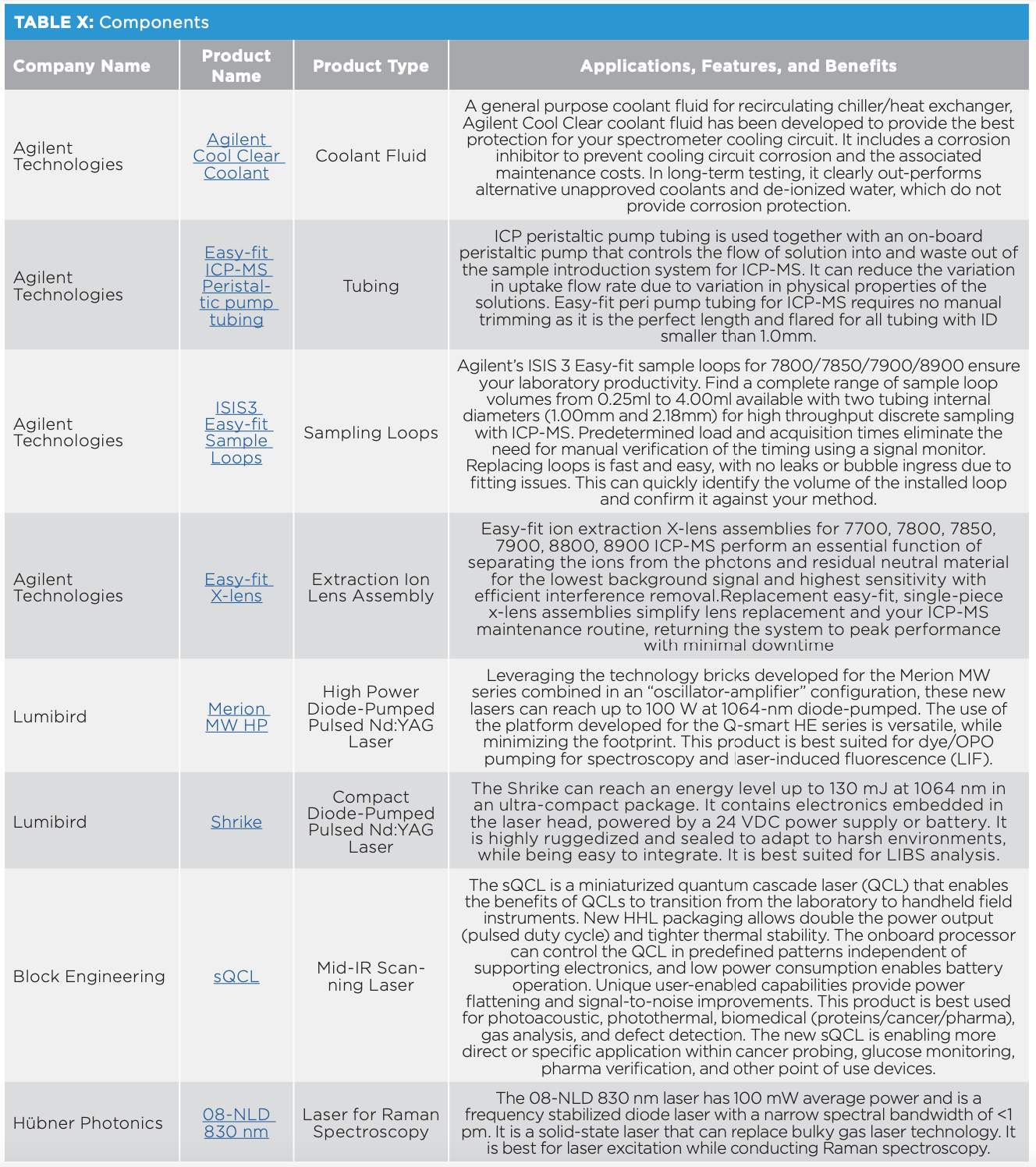
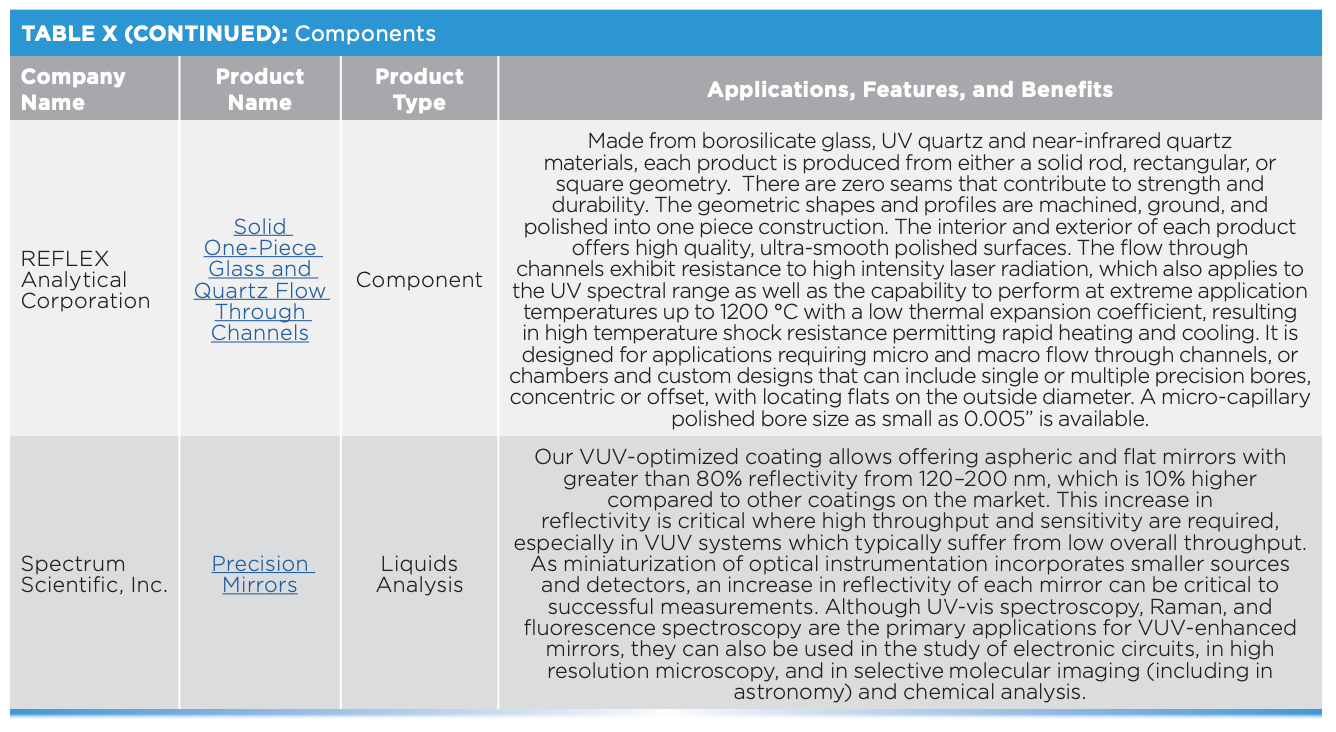
Agilent has introduced a number of supplies to simplify maintaining inductively coupled plasma mass spectrometry (ICP-MS) systems. They include a new coolant with corrosion inhibitors, tubing for ICP-MS pump systems, sample introduction loops to assure fixed volume introductions and easy-fit ICP-MS extraction ion lens assemblies. All four of these supplies are designed to improve analysis and minimize downtime.
Hübner Photonics has introduced an 830 nm laser with a narrow spectral bandwidth especially suited for Raman spectroscopy.
Lumibird has introduced two neodymium-doped yttrium aluminum garnet (Nd:YAG) lasers. The first, the Merion MW HP, is a high-power pumped laser suitable for dye/OPO pumping or laser induced fluorescence. The other introduction, the Shrike, is a compact laser, powered by 24 VDC or a battery, and is especially suited to LIBS analysis.
The last product in the laser category is a miniaturized scanning quantum cascade laser from Block Engineering. This miniaturized laser allows the transition from laboratory to handheld or field instruments.
Reflex Analytical also has an entry in the components category. They have introduced flow-through cells in borosilicate glass, UV quartz, and NIR quartz materials for applications in micro and macro flow systems.
Our final entry in the components space, Spectrum Scientific, has introduced precision mirrors with a vacuum UV optimized coating for use in the 120–200 nm range.
Software
As some will tell you, instrument and data analysis software are more important than the actual hardware. Table XI shows the software packages introduced over the past year. LabVantage Solutions Inc. has introduced a new version of their LIMS system, providing features and enhancements for the user. For industry specific applications, they have also introduced the LabVantage Forensic Navigator that creates a seamless platform from evidence collection and storage, laboratory testing, case compilation, and proceedings while providing robust quality management.

The next two software systems are instrument-based and provide capabilities to control and process data. Metrohm has introduced the Vision software to simplify the control and analysis of Metrohm/B&W Tek NIR and Raman instruments. WITec has introduced the Suite SIX for Raman and correlative microscopy. This new package adds user management and the ability to define distinct hardware setups to streamline recurring experiments.
Finally, John Wiley & Sons, Inc. have introduced KnowItAll 2023. This release expands the KnowItAll capabilities to include a patented solution to analyze vapor-phase IR spectra of synthetic cannabinoids, adaptive searching and more support for MS and nuclear magnetic resonance (NMR).
Trends and Conclusions
The trends in instrumentation and software continue to see products that are smaller, easier to use, and application-specific. Although general purpose instruments still hold a big share of the analytical instrument business, it was evident as I walked the aisles of Pittcon that many of the products were geared toward increasing productivity and ease of use, to the point that specific workflows for particular analyses are provided.
These trends might be pushing the users to treat instruments and software as answer boxes. This presents a problem. If you do not understand how a device works, what the steps in the procedure were, and what to expect, then you may not recognize a problem.
A class of exhibitors at Pittcon, which are not usually described in these reviews, are the professional societies and the publishers. The original name of the conference was The Pittsburgh Conference on Analytical Chemistry and Applied Spectroscopy. There were a number of organizations represented at the conference that fall under that banner. They include the American Chemical Society, The Coblentz Society, the Federation of Analytical Chemistry and Spectroscopy Societies, the Royal Society of Chemistry, and the Society for Applied Spectroscopy, all of whom are committed to educating the user base of analytical instruments particularly spectroscopy. These organizations, along with the publishers that were also represented, such as John Wiley & Sons, LabX Media Group, and MJH Life Sciences (the parent organization of this publication) strive to also provide useful and educational information for the instrument user.
I would highly encourage the reader of this article to take advantage of these resources. Yes, follow the instructions provided by an instrument company for the use of the instrument, but tap the professional societies and publishers for resources to gain more information, or become part of a community where everyone speaks the same technical language and is willing to share their expertise.
If your organization introduces a new product in the coming months, please submit the 2024 Spectroscopy New Product form that can be found at https://www.spectroscopyonline.com/view/spectroscopy-new-product-review. We will be accepting submissions as the products are introduced and include the appropriate products in the 2024 review.
Ellen Miseo is a consultant in vibrational spectroscopy and spectroscopy education. She is the past president of both the Coblentz Society and the Society for Applied Spectroscopy, and serves on the Spectroscopy Editorial Advisory board. Direct correspondence to: SpectroscopyEdit@mmhgroup.com ●
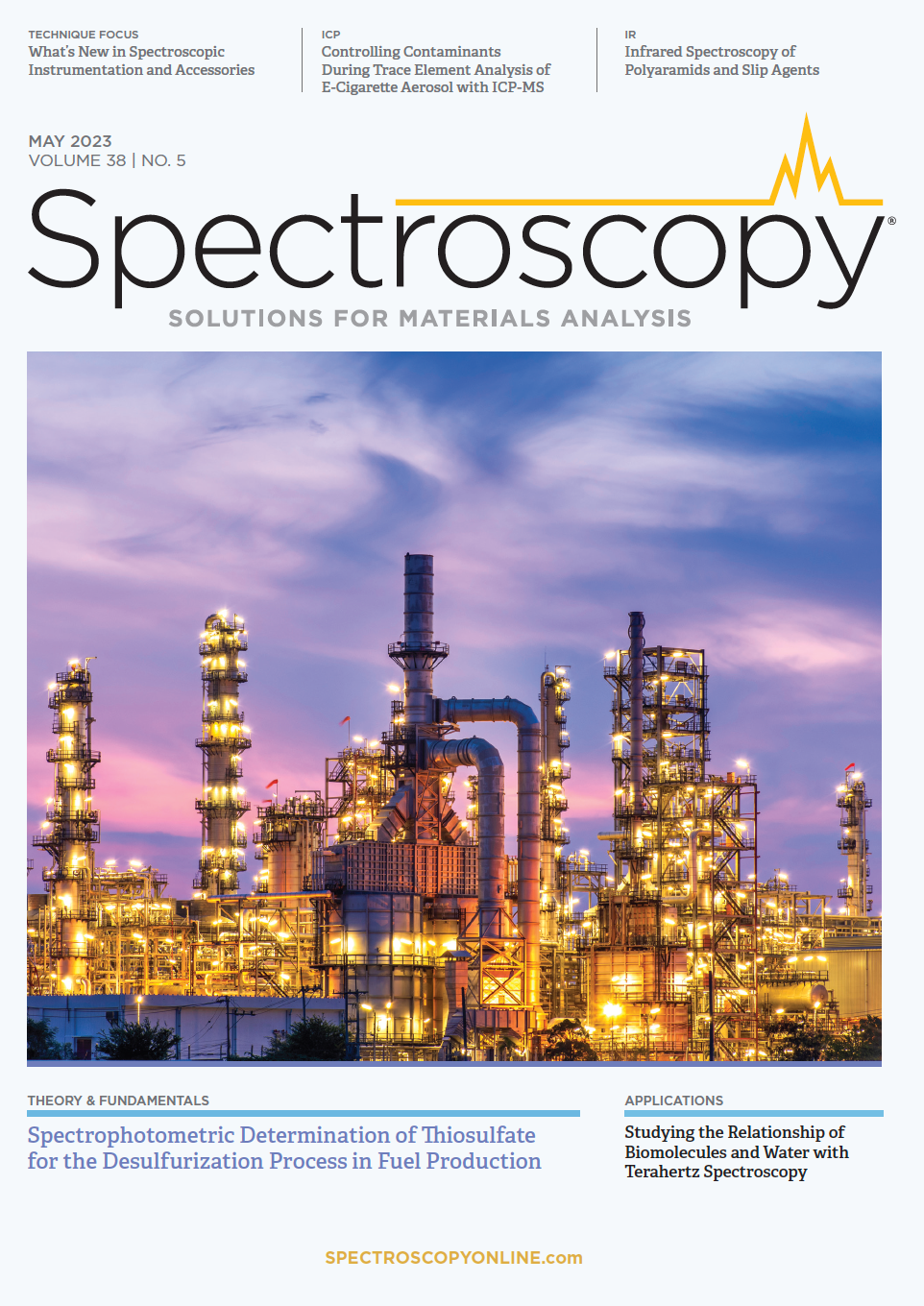
LIBS Illuminates the Hidden Health Risks of Indoor Welding and Soldering
April 23rd 2025A new dual-spectroscopy approach reveals real-time pollution threats in indoor workspaces. Chinese researchers have pioneered the use of laser-induced breakdown spectroscopy (LIBS) and aerosol mass spectrometry to uncover and monitor harmful heavy metal and dust emissions from soldering and welding in real-time. These complementary tools offer a fast, accurate means to evaluate air quality threats in industrial and indoor environments—where people spend most of their time.
Trends in Infrared Spectroscopic Imaging
September 13th 2013An interview with Rohit Bhargava, winner of the 2013 Craver Award. This interview is part of the 2013 podcast series presented in collaboration with the Federation of Analytical Chemistry and Spectroscopy Societies (FACSS), in connection with SciX 2013, the federation?s North American conference.
New Study Reveals Insights into Phenol’s Behavior in Ice
April 16th 2025A new study published in Spectrochimica Acta Part A by Dominik Heger and colleagues at Masaryk University reveals that phenol's photophysical properties change significantly when frozen, potentially enabling its breakdown by sunlight in icy environments.
New Raman Spectroscopy Method Enhances Real-Time Monitoring Across Fermentation Processes
April 15th 2025Researchers at Delft University of Technology have developed a novel method using single compound spectra to enhance the transferability and accuracy of Raman spectroscopy models for real-time fermentation monitoring.